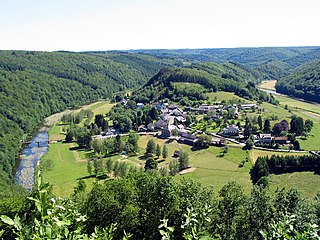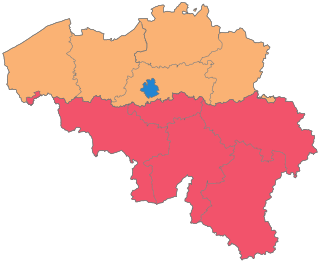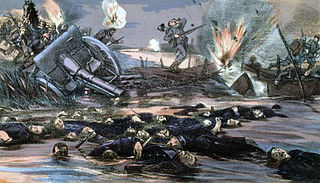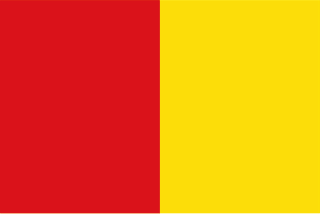Contents
| |||||
| Decades: | |||||
|---|---|---|---|---|---|
| See also: | Other events of 1915 List of years in Belgium | ||||
Events in the year 1915 in Belgium .
| |||||
| Decades: | |||||
|---|---|---|---|---|---|
| See also: | Other events of 1915 List of years in Belgium | ||||
Events in the year 1915 in Belgium .

Walloons are a Gallo-Romance ethnic group native to Wallonia and the immediate adjacent regions of Flanders, France, Germany, Luxembourg and the Netherlands. Walloons primarily speak langues d'oïl such as Belgian French, Picard and Walloon. Walloons are primarily Roman Catholic, with a historical minority of Protestantism which dates back to the Reformation era.

Wallonia, officially the Walloon Region, is one of the three regions of Belgium—along with Flanders and Brussels. Covering the southern portion of the country, Wallonia is primarily French-speaking. It accounts for 55% of Belgium's territory, but only a third of its population. The Walloon Region and the French Community of Belgium, which is the political entity responsible for matters related mainly to culture and education, are independent concepts, because the French Community of Belgium encompasses both Wallonia and the bilingual Brussels-Capital Region but not the German-speaking Community of Belgium.

The Ardennes, also known as the Ardennes Forest or Forest of Ardennes, is a region of extensive forests, rough terrain, rolling hills and ridges primarily in Belgium and Luxembourg, extending into Germany and France.

Liège is the easternmost province of the Wallonia region of Belgium.

The Kingdom of Belgium is divided into three regions. Two of these regions, Flanders and Wallonia, are each subdivided into five provinces. The third region, Brussels, does not belong to any province and nor is it subdivided into provinces. Instead, it has amalgamated both regional and provincial functions into a single "Capital Region" administration.
Articles related to Belgium include:

Dinant is a city and municipality of Wallonia located in the province of Namur, Belgium. On the shores of river Meuse, in the Ardennes, it lies 90 kilometres (56 mi) south-east of Brussels, 30 kilometres (19 mi) south-east of Charleroi and 30 kilometres (19 mi) south of the city of Namur. Dinant is situated 20 kilometres (12 mi) north of the border with France.

The Battle of the Yser was a battle of the First World War that took place in October 1914 between the towns of Nieuwpoort and Diksmuide, along a 35 km (22 mi) stretch of the Yser River and the Yperlee Canal, in Belgium. The front line was held by a large Belgian force, which halted the German advance in a costly defensive battle.

The Prince-Bishopric of Liège or Principality of Liège was an ecclesiastical principality of the Holy Roman Empire that was situated for the most part in present-day Belgium. It was an Imperial Estate, so the bishop of Liège, as its prince, had a seat and a vote in the Imperial Diet. The Prince-Bishopric of Liège should not be confused with the Diocese of Liège, which was larger and over which the prince-bishop exercised only the usual responsibilities of a bishop.

The Rape of Belgium was a series of systematic war crimes, especially mass murder and deportation, by German troops against Belgian civilians during the invasion and occupation of Belgium during World War I.

Joseph Van Daele was a Belgian champion cyclist who was a professional rider between 1912 and 1926. He participated in many top cycle races of the time including the Tour de France where he finished eighth in 1919.

Raymond Impanis was a Belgian professional cyclist from 1947 to 1963. He won Paris–Roubaix, the Tour of Flanders, Gent–Wevelgem and three stages in Tour de France.

The German invasion of Belgium was a military campaign which began on 4 August 1914. On 24 July, the Belgian government had announced that if war came it would uphold its neutrality. The Belgian government mobilised its armed forces on 31 July and a state of heightened alert was proclaimed in Germany. On 2 August, the German government sent an ultimatum to Belgium, demanding passage through the country and German forces invaded Luxembourg. Two days later, the Belgian government refused the German demands and the British government guaranteed military support to Belgium. The German government declared war on Belgium on 4 August; German troops crossed the border and began the Battle of Liège.

Partial general elections were held in Belgium on 24 May 1914. The result was a victory for the Catholic Party, which won 41 of the 88 seats up for election in the Chamber of Representatives.

The history of Belgium in World War I traces Belgium's role between the German invasion in 1914, through the continued military resistance and occupation of the territory by German forces to the armistice in 1918, as well as the role it played in the international war effort through its African colony and small force on the Eastern Front.
Events from the year 1914 in Belgium.

The De Broqueville government in Sainte-Adresse refers to two successive Belgian governments, led by Charles de Broqueville, which served as governments in exile during the German occupation of Belgium in World War I. They were based in Le Havre in northern France after October 1914. The first government, known as the First de Broqueville government, was a Catholic government which was elected in 1911 and continued until 1916, when it was joined by Socialists and Liberals expanding it into the Second de Broqueville government, which lasted until 1 June 1918. In November 1914, the vast majority of Belgian territory was under German occupation. The only portion of Belgium that remained controlled by the Kingdom of Belgium in exile was the strip of territory behind the Yser Front.
Events in the year 1917 in Belgium.
Events in the year 1918 in Belgium.

The German atrocities of 1914 were committed by the Imperial German Army at the beginning of World War I in Belgium, particularly in Wallonia, and in France in the departments of Meuse, Ardennes, and Meurthe-et-Moselle.